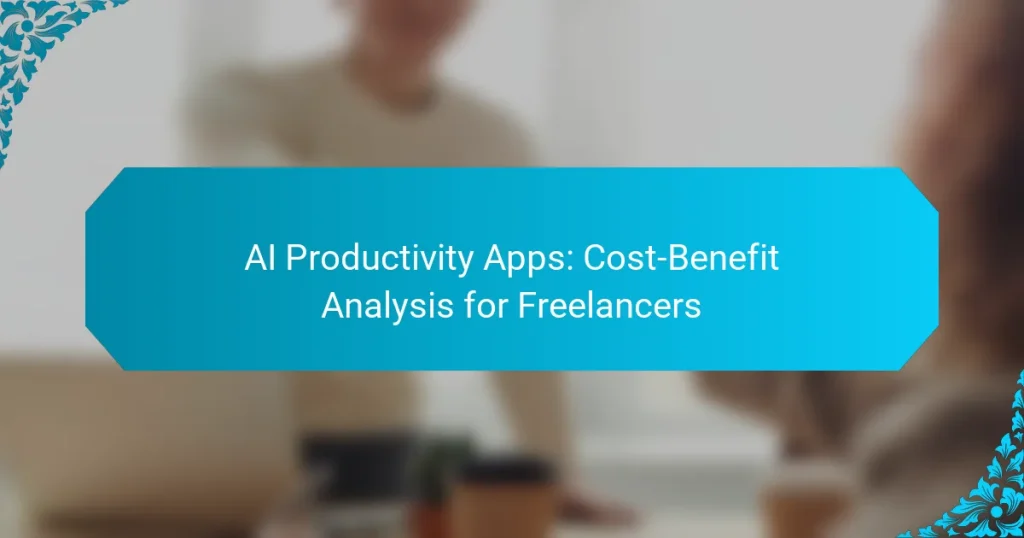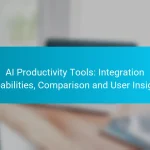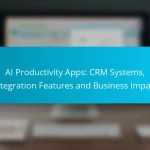AI productivity apps are transforming the freelance landscape by streamlining workflows and enhancing time management. By automating repetitive tasks and improving collaboration, these tools allow freelancers to focus on their core competencies while maximizing efficiency. However, it’s essential to conduct a cost-benefit analysis to determine which apps best align with individual needs and budget constraints.
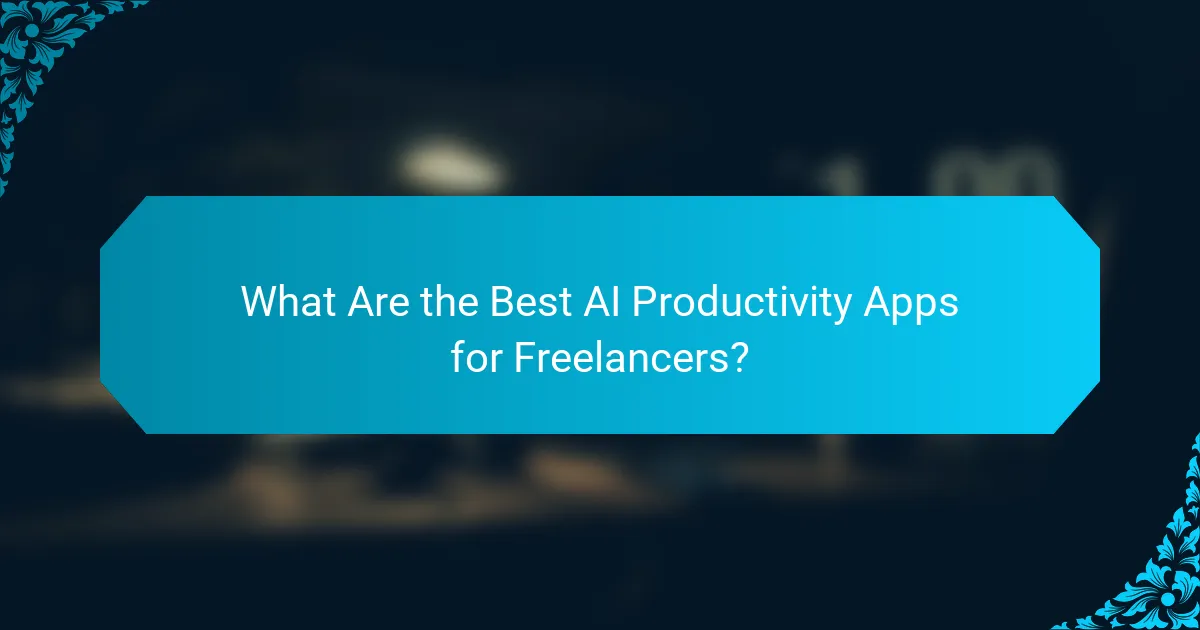
What Are the Best AI Productivity Apps for Freelancers?
The best AI productivity apps for freelancers enhance efficiency and organization, allowing for better time management and task prioritization. Popular options include Notion, Trello, Todoist, Asana, and ClickUp, each offering unique features tailored to different workflows.
Notion
Notion is an all-in-one workspace that combines notes, tasks, databases, and calendars. Freelancers can customize their dashboards to suit their specific needs, making it ideal for project management and documentation.
Consider using Notion for client management or content planning. Its flexibility allows you to create templates that can save time and streamline your processes.
Trello
Trello uses a card-based system to organize tasks visually, making it easy to track project progress. Each card can contain checklists, due dates, and attachments, which helps freelancers manage multiple projects simultaneously.
Utilize Trello’s boards for different clients or projects, and take advantage of its automation features to reduce repetitive tasks. Keep in mind that while Trello is user-friendly, it may lack some advanced features found in other tools.
Todoist
Todoist is a task management app that helps freelancers prioritize their daily activities. With features like recurring tasks and project categorization, it simplifies keeping track of deadlines and responsibilities.
To maximize Todoist’s effectiveness, set up projects for each client and use labels for task types. This organization can help you focus on what’s most important each day.
Asana
Asana is designed for team collaboration but is equally beneficial for freelancers managing complex projects. It offers task assignments, timelines, and progress tracking, making it easier to stay on schedule.
Consider using Asana for larger projects that require detailed planning and collaboration with clients. Its reporting features can also provide insights into your productivity trends over time.
ClickUp
ClickUp is a versatile productivity platform that combines task management, time tracking, and goal setting. Its customizable features cater to various workflows, making it suitable for freelancers with diverse needs.
Leverage ClickUp’s integrations with other tools you use, such as Google Drive or Slack, to create a seamless workflow. Be mindful of its extensive features, as it can be overwhelming for new users; start with the basics and expand as needed.
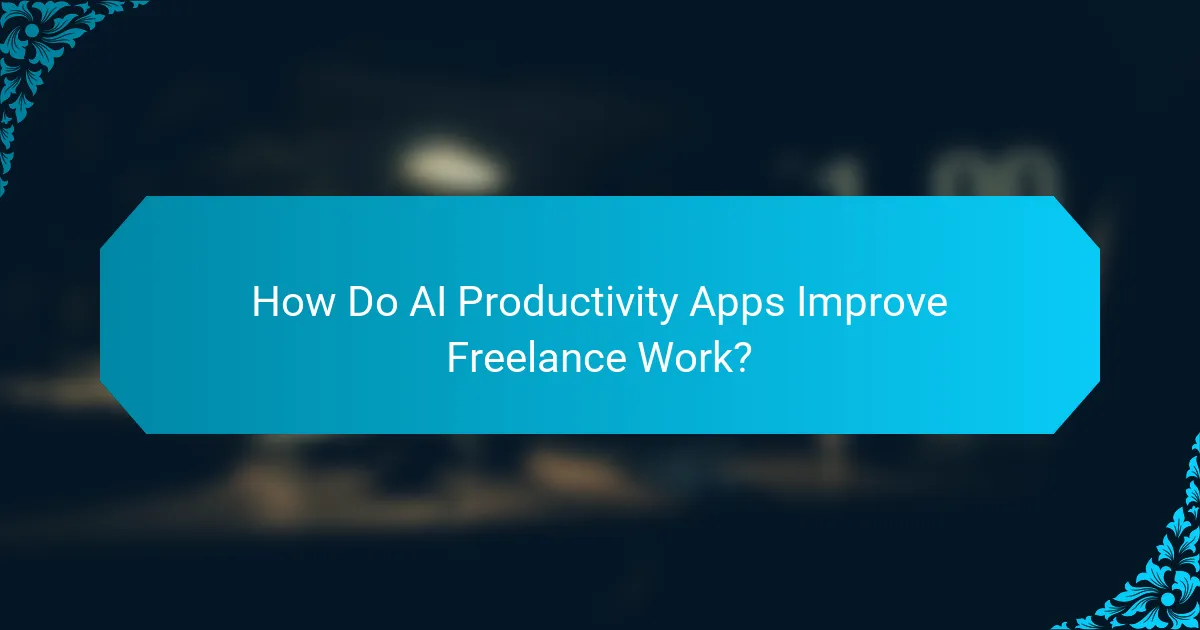
How Do AI Productivity Apps Improve Freelance Work?
AI productivity apps enhance freelance work by automating repetitive tasks, optimizing time management, and facilitating collaboration. These tools help freelancers focus on their core competencies while improving efficiency and output quality.
Task Automation
Task automation in AI productivity apps allows freelancers to streamline their workflows by handling routine activities. For instance, invoicing, email responses, and data entry can be automated, saving hours each week. This enables freelancers to allocate more time to creative and high-value tasks.
When selecting an automation tool, consider features like integration with existing software and user-friendliness. Popular options often include Zapier and IFTTT, which connect various applications to automate tasks without coding knowledge.
Time Management
Effective time management is crucial for freelancers, and AI apps can significantly enhance this aspect. Tools like time trackers and scheduling assistants help freelancers monitor their work hours and prioritize tasks efficiently. For example, apps like Toggl and Clockify can provide insights into how time is spent across projects.
To maximize productivity, set clear goals and deadlines within these apps. Regularly review your time logs to identify areas for improvement and adjust your workflow accordingly. Aim to allocate specific time blocks for focused work to minimize distractions.
Collaboration Features
Collaboration features in AI productivity apps facilitate seamless communication and project management among freelancers and clients. Tools like Slack and Trello enable real-time updates and task assignments, ensuring everyone stays aligned. This is particularly beneficial for freelancers who often juggle multiple clients or projects.
When choosing a collaboration tool, look for features such as file sharing, comment threads, and integration with other apps. Establish clear communication protocols to avoid misunderstandings and ensure that all team members are on the same page throughout the project lifecycle.
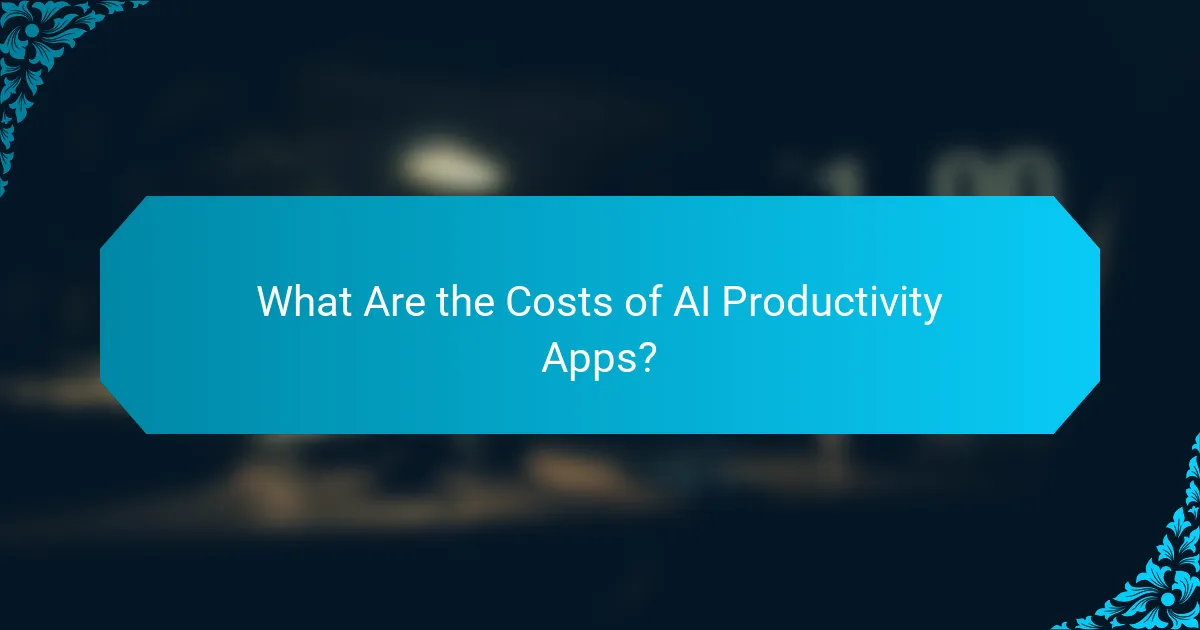
What Are the Costs of AI Productivity Apps?
The costs of AI productivity apps can vary significantly based on the pricing structure, features offered, and user needs. Understanding these costs helps freelancers make informed decisions about which tools to invest in for enhancing their productivity.
Subscription Models
Many AI productivity apps operate on a subscription model, charging users monthly or annually. This approach often provides access to the latest features and updates, but costs can accumulate over time. Freelancers should evaluate whether the ongoing expense aligns with their budget and productivity gains.
Typical subscription fees can range from around $5 to $50 per month, depending on the app’s capabilities. It’s advisable to compare different subscription tiers to find the best value for specific needs.
One-Time Purchases
Some AI productivity tools offer one-time purchase options, allowing users to pay a single fee for lifetime access. This can be beneficial for freelancers who prefer to avoid recurring costs. However, one-time purchases may not include future updates or support, which could lead to additional expenses down the line.
Prices for one-time purchases can vary widely, often falling between $20 and $200. Freelancers should consider the long-term value and potential need for updates when choosing this option.
Free vs Paid Versions
Many AI productivity apps provide both free and paid versions, each with distinct features. Free versions typically offer basic functionalities, while paid versions unlock advanced tools and capabilities. Freelancers should assess whether the free version meets their needs or if the additional features in the paid version justify the cost.
It’s common for free versions to have limitations, such as restricted usage or fewer integrations. Freelancers might start with a free version to gauge effectiveness before committing to a paid plan, ensuring they make a cost-effective choice.
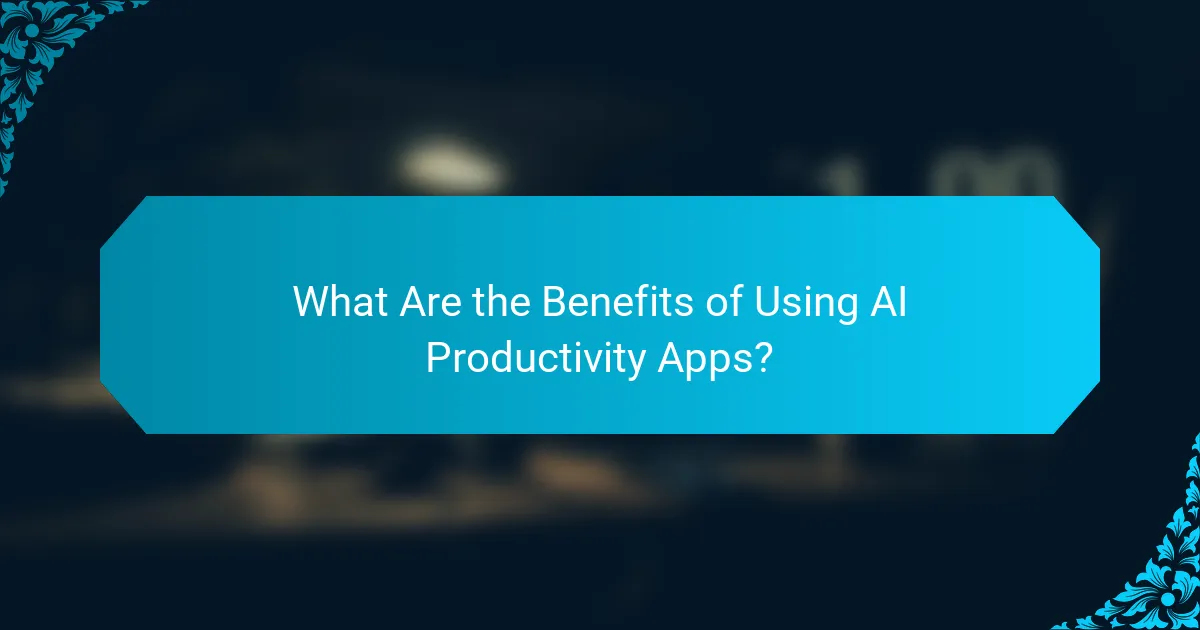
What Are the Benefits of Using AI Productivity Apps?
AI productivity apps offer freelancers significant advantages, including time savings, better organization, and enhanced focus. By automating repetitive tasks and providing smart insights, these tools can help freelancers maximize their output and streamline their workflows.
Increased Efficiency
AI productivity apps can significantly boost efficiency by automating mundane tasks such as scheduling, invoicing, and data entry. For instance, tools like calendar assistants can manage appointments, reducing the time spent on back-and-forth communications.
Freelancers often find that using AI-driven tools can cut task completion time by 20-50%, allowing them to take on more projects or enjoy additional free time. However, it’s essential to evaluate the learning curve associated with new tools to ensure the time saved outweighs the time spent learning.
Enhanced Organization
These applications help freelancers maintain better organization by centralizing project management, document storage, and communication. Tools like Trello or Asana can provide visual task boards that make tracking progress straightforward and intuitive.
Utilizing AI for organization can lead to a more structured workflow, reducing the chances of missed deadlines or overlooked tasks. Freelancers should consider integrating these apps with existing systems to create a seamless experience and avoid the pitfalls of disjointed information management.
Improved Focus
AI productivity apps can enhance focus by minimizing distractions and providing personalized recommendations on task prioritization. Features like focus timers or distraction blockers can help freelancers stay on track during work hours.
For example, using a Pomodoro timer app can encourage bursts of concentrated work followed by short breaks, which research suggests can improve overall productivity. Freelancers should experiment with different focus-enhancing features to find what best suits their working style and helps maintain sustained attention.
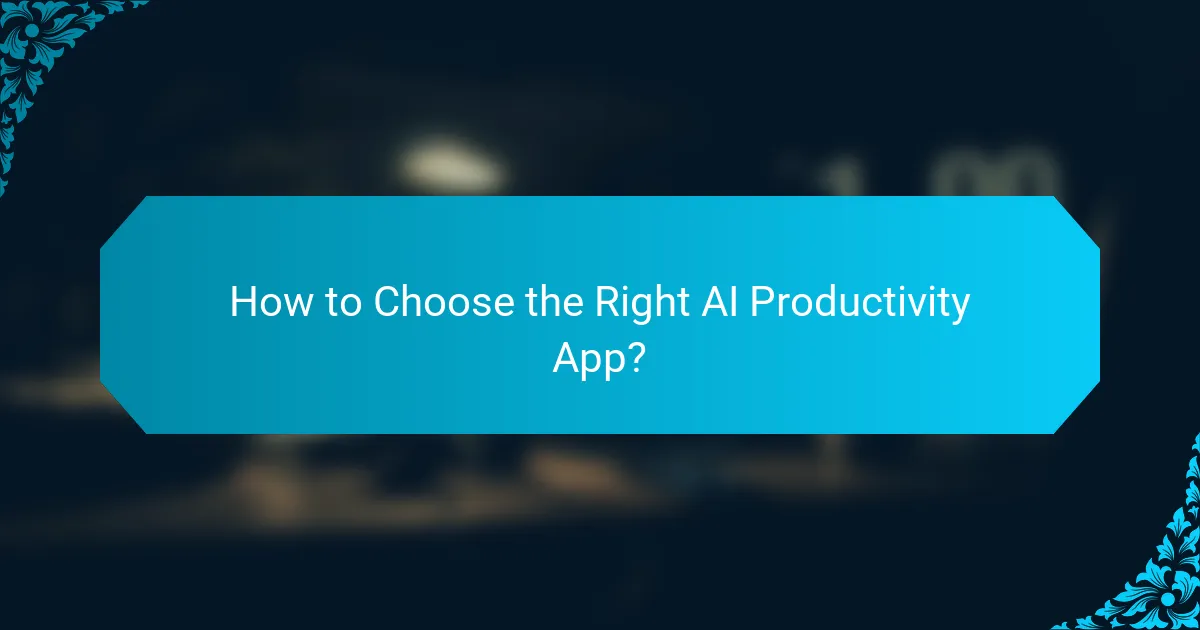
How to Choose the Right AI Productivity App?
Selecting the right AI productivity app involves understanding your specific needs, comparing features, and reviewing user feedback. This process ensures you choose a tool that effectively enhances your workflow and meets your budget.
Identify Your Needs
Begin by assessing the tasks you want the AI app to assist with, such as project management, time tracking, or content generation. Consider whether you need features like collaboration tools, integrations with other software, or mobile accessibility.
For freelancers, prioritizing features that save time and streamline processes is crucial. For instance, if you often manage multiple projects, look for apps that offer robust task management capabilities.
Compare Features
Once you have a clear understanding of your needs, compare the features of different AI productivity apps. Create a checklist of must-have functionalities versus nice-to-have features to help narrow down your options.
For example, if you require advanced analytics, focus on apps that provide detailed reporting. Additionally, consider the ease of use, as a user-friendly interface can significantly impact your productivity.
Read User Reviews
User reviews can provide valuable insights into the real-world performance of AI productivity apps. Look for feedback on aspects such as reliability, customer support, and overall satisfaction to gauge how well the app meets user expectations.
Pay attention to reviews from freelancers, as they will highlight features and challenges specific to your work style. Platforms like G2 or Capterra can be useful for finding comprehensive user feedback and ratings.
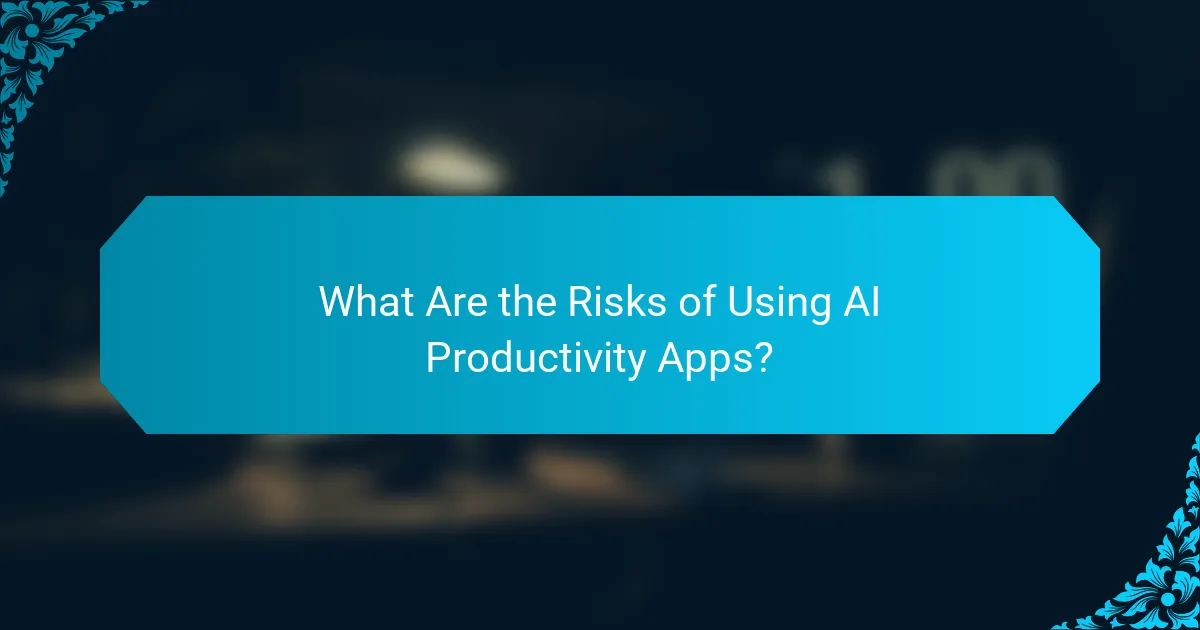
What Are the Risks of Using AI Productivity Apps?
Using AI productivity apps can pose several risks, particularly regarding data privacy, reliance on technology, and potential inaccuracies in output. Freelancers should weigh these risks against the benefits to make informed decisions about their use.
Data Privacy Concerns
Data privacy is a significant risk when using AI productivity apps, as these tools often require access to sensitive information. Freelancers must be cautious about sharing client data or proprietary information, as breaches can lead to serious consequences.
To mitigate these risks, review the app’s privacy policy and data handling practices. Look for apps that comply with regulations like GDPR or CCPA, which offer protections for personal data. Additionally, consider using tools that allow for local data storage rather than cloud-based solutions.
Always use strong passwords and enable two-factor authentication where possible. Regularly audit the permissions granted to these apps and limit access to only what is necessary for their functionality.
